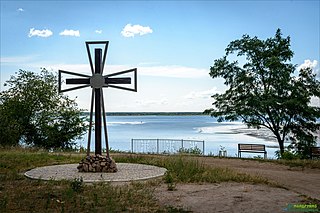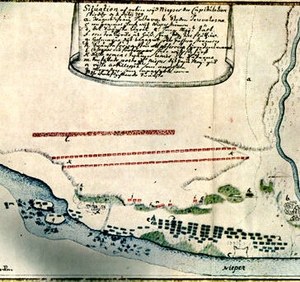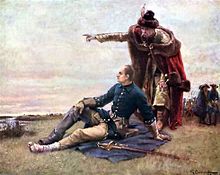
The Battle of Lesnaya was one of the major battles of the Great Northern War. It took place on October 9 [O.S. September 28] 1708 between a Russian army of between 26,500 and 29,000 men commanded by Peter I of Russia, Mikhail Mikhailovich Golitsyn, Aleksandr Danilovich Menshikov, Christian Felix Bauer and Nikolai Grigorovitj von Werden and a Swedish army of about 12,500 men commanded by Adam Ludwig Lewenhaupt and Berndt Otto Stackelberg, at the village of Lesnaya, located close to the border between the Polish–Lithuanian Commonwealth and Russia. The Swedes were escorting a supply column of more than 4,500 wagons for their main army in Ukraine.

The Great Northern War (1700–1721) was a conflict in which a coalition led by the Tsardom of Russia successfully contested the supremacy of the Swedish Empire in Northern, Central and Eastern Europe. The initial leaders of the anti-Swedish alliance were Peter I of Russia, Frederick IV of Denmark–Norway and Augustus II the Strong of Saxony–Poland–Lithuania. Frederick IV and Augustus II were defeated by Sweden, under Charles XII, and forced out of the alliance in 1700 and 1706 respectively, but rejoined it in 1709 after the defeat of Charles XII at the Battle of Poltava. George I of Great Britain and the Electorate of Hanover joined the coalition in 1714 for Hanover and in 1717 for Britain, and Frederick William I of Brandenburg-Prussia joined it in 1715.

The Battle of Poltava was the decisive and largest battle of the Great Northern War. A Russian army under the command of Tsar Peter I defeated a Swedish army, under the command of Carl Gustaf Rehnskiöld. The battle put an end to the status of the Swedish Empire as a European great power, as well as its eastbound expansion, and marked the beginning of Russian influence in Northern Europe.

The Battle of the Vorskla River was fought on August 12, 1399, between the Tatars of the Golden Horde, under Edigu and Temür Qutlugh, and the armies of Tokhtamysh and a large Crusader force led by Grand Duke Vytautas of Lithuania. The battle ended in a decisive Tatar victory for the Golden Horde.

The Battle of Holowczyn was fought in July 1708 between the Russian army, and the Swedish army, led by Charles XII of Sweden, only 26 years of age at the time. Despite difficult natural obstacles and superior enemy artillery, the Swedes were able to achieve surprise and defeat the numerically superior Russian forces, who were separated from each other, had no overall command and could not coordinate their actions, disallowing them an engagement in full force. Reportedly, it was Charles' favourite victory.

Perevolochna is a former fortress and town in the Polish–Lithuanian Commonwealth and Cossack Hetmanate, and later a village in Poltava Oblast. Before the establishment of Kamianske Water Reservoir in the 1960s, here also existed a river crossing. The settlement was situated at the bank of the Dnieper near the mouth of Vorskla River, where a ford across Dnieper enabled people to cross the river, hence its name. The crossing Perevolochna – Mishuryn Rih was also a key crossing during the Battle of the Dnieper in October 1943.

The military history of the Russian Empire encompasses the history of armed conflict in which the Russian Empire participated. This history stretches from its creation in 1721 by Peter the Great, until the Russian Revolution (1917), which led to the establishment of the Soviet Union. Much of the related events involve the Imperial Russian Army, Imperial Russian Navy, and from the early twentieth century, the Imperial Russian Air Service.

Count Carl Gustav Rehnskiöld was a Swedish Field Marshal (fältmarskalk) and Royal Councillor. He was mentor and chief military advisor to King Charles XII of Sweden, and served as deputy commander-in-chief of the Carolean Army, an army he assisted both in its education and development.

The invasion of Russia by Charles XII of Sweden was a campaign undertaken during the Great Northern War between Sweden and the allied states of Russia, Poland, and Denmark. The invasion began with Charles's crossing of the Vistula on 1 January 1708, and effectively ended with the Swedish defeat in the Battle of Poltava on 8 July 1709, though Charles continued to pose a military threat to Russia for several years while under the protection of the Ottoman Turks.

The Battle of Poniec took place on October 28, 1704 in Poniec, Poland, during the Great Northern War. The Swedish Army under Charles XII unsuccessfully dislodged the Saxon Army under Johann Matthias von der Schulenburg through several cavalry charges. The Saxons had deployed in a massive square formation near the village of Janiszewo, west of Poniec.

The Battle of Grodno (1706) refers to the battle during the Great Northern War. Grodno was a city of the Polish–Lithuanian Commonwealth at this time.

The Battle of Kletsk took place on 30 April 1706, in- and outside the city of Kletsk, Belarus during Charles XII's Polish campaign of 1701–1706, in the Great Northern War. The Swedish forces were led by Carl Gustaf Creutz who defeated a larger Russian–Cossack force under the command of Semjon Nepljujev and Danylo Apostol. Many of the Russian and Cossack regiments participating in the battle were wiped out and ceased to exist as fighting units.

The Battle of Krasnokutsk–Gorodnoye took place on February 20–22, 1709, in the Swedish campaign of Russia during the Great Northern War. The Swedish troops were directly led by Charles XII King of Sweden who pursued a force of Russians commanded by Otto Rudolf von der Schaumburg from the minor battle of Krasnokutsk to the town Gorodnoye where a new battle took place, with the Russians now commanded by Karl Evald von Rönne. The Swedes were victorious but cancelled their offensive when the night fell.
The following units fought in the Battle of Lesnaya on October 9, 1708 during the Great Northern War.
The Battle of Rajovka took place on September 20, 1708 near Rajovka during the Swedish invasion of Russia in the Great Northern War. The Swedish army of about 2,400 men under the command of Charles XII defeated the Russian army of 10,000 men under Christian Felix Bauer after a fierce cavalry skirmish where the king himself was in great danger.
The Battle of Oposhnya was a battle which took place on February 8, 1709 during the Swedish invasion of Russia in the Great Northern War.
The Battle of the Neva was a battle which took place on September 9, 1708 during the Swedish invasion of Russia in the Great Northern War. While Charles XII had started his offensive against Russia from his winter quarters in Saxony, the Swedish–Finnish army of 12,000 men under the command of Georg Lybecker went in field to interrupt and possibly capture the newly-established ports and town of Saint Peterburg, which had been built on Swedish land. This was intended to draw the attention and troops from the main Russian army facing Charles. The Russian forces stationed in Ingria consisted of 24,500 men of which the command had been appointed to Fyodor Apraksin. While having reached the river of Neva the Swedes under Lybecker prepared their crossing. Apraksin had fortified the opposite bank with about 8,000 men and several boats patrolling the river.
The Ural Swedes, were Yaik Cossacks with Swedish ancestry, related to the large groups of Swedish prisoners of the Great Northern War (1700–1721).

The Campaign of Grodno was a plan developed by Johann Patkul and Otto Arnold von Paykull during the Swedish invasion of the Polish–Lithuanian Commonwealth, a part of the Great Northern War. Its purpose was to crush Charles XII's army with overwhelming force in a combined offensive of Russian and Saxon troops. The campaign, executed by Peter I of Russia and Augustus II of Saxony, began in July 1705 and lasted almost a year. In divided areas the allies would jointly strike the Swedish troops occupied in Poland, in order to neutralize the influence the Swedes had in the Polish politics. However, the Swedish forces under Charles XII successfully outmaneuvered the allies, installed a Polish king in favor of their own and finally won two decisive victories at Grodno and Fraustadt in 1706. This resulted in the Treaty of Altranstädt (1706) in which Augustus renounced his claims to the Polish throne, broke off his alliance with Russia, and established peace between Sweden and Saxony.

The Great Northern War in Ukraine (1708–1713) — war between the Tsardom of Russia on one hand and the Swedish Empire and the Ottoman Empire on the other.















